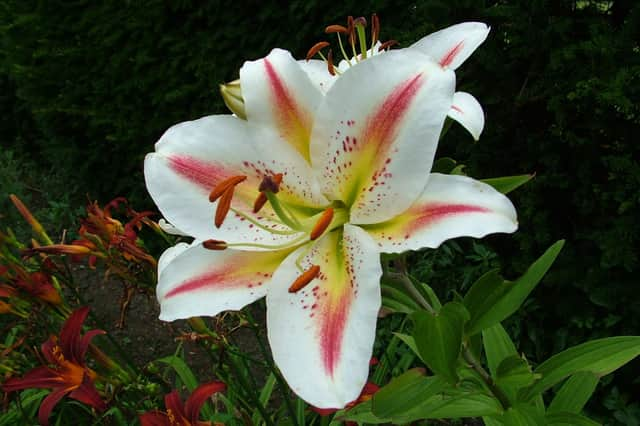Gardening: Lilies – they’re easy to grow and have a wonderful scent | Brian Kidd


Those who have small gardens will love them because they grow wonderfully well in pots and containers.
This weekend is the perfect time to plant them and, if you were organised and bought them before everywhere closed, there were lots to choose from.
Advertisement
Hide AdAdvertisement
Hide AdMake sure pots have holes in the base and put a layer of broken flowerpots (crocks) in the bottom for good drainage.
John Innes No3 compost is good but it needs to have extra sharp sand and more organic matter. I suggest using JI compost but add 10 per cent sharp sand and 20 per cent loamless universal compost. Any loamless compost will be OK. Mix it together really well.
When I was an apprentice we used well-rotted leaf mould instead of peat. The mixture we had to amalgamate was seven parts rotted turf sieved through a quarter-of-an-inch sieve (the size of the holes, not the sieve!). This took hours and a piece of 4x2in wood six inches long helped get it through the mesh. To this was then mixed six parts leaf mould, again sieved and, finally, Chichester grit. The formula was seven parts loam (rotted turfs); three parts leaf mould and two parts Chichester grit, but these days we would use potting sand.
When choosing the bulbs look at the pictures on the packs, then check heights. You don’t need a variety which is 120cm (4ft) if you are growing them on a balcony near the seafront. Remember 30cm equals 12in. Bulbs are planted point upwards. Pour three inches of compost into a 10-12in pot. Plant three bulbs of the same variety on top of the compost then fill the pot to within an inch of the top before watering the compost. Little feet beneath the pot keep worms out.
Advertisement
Hide AdAdvertisement
Hide AdLilies of all types can be grown in borders. They love having their roots in the shade but the flowers must be up in the sun. They are all hardy so there’s no need to take them out in the autumn, in fact they are better left to naturalise.
If you want to increase numbers, do it as soon as the stems die down. Dig them up, split the bulbs and plant back again straight away. Never allow them to dry out in the wind.
Two problems. Firstly, the lily beetle which is bright red, half an inch long, and eats the leaves during the summer as if there is no tomorrow. Pick them off every day and squash them. Provado Ultimate Bug Killer will kill them. Spray the leaves but not the blooms. Or smear vaseline inside a screw-top jar and take it into the garden every day. Pick off the beetles, drop them in the jar and replace the lid. This avoids using chemicals.
Secondly, the ginger-coloured pollen is poisonous to cats. If you’re a cat lover, cut off the anthers with scissors. There is a bonus. You won’t get pollen on your nose when you take a deep sniff. Perfume in the garden is good for you; it makes you smile!
THIS WEEK’S TOP TIP
Think ahead. Where are cabbages to be planted? All types of cabbage need lime in the soil. Apply lime at a rate of four to eight ounces per square yard where cabbages will be planted.
Comment Guidelines
National World encourages reader discussion on our stories. User feedback, insights and back-and-forth exchanges add a rich layer of context to reporting. Please review our Community Guidelines before commenting.